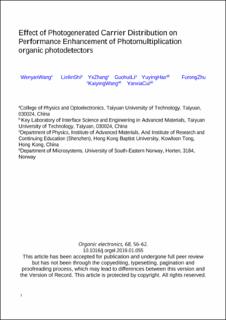| dc.contributor.author | Wang, Wenyan | |
| dc.contributor.author | Shi, Linlin | |
| dc.contributor.author | Zhang, Ye | |
| dc.contributor.author | Li, Guohui | |
| dc.contributor.author | Hao, Yuying | |
| dc.contributor.author | Zhu, Furong | |
| dc.contributor.author | Wang, Kaiying | |
| dc.contributor.author | Cui, Yanxia | |
| dc.date.accessioned | 2020-04-15T10:58:12Z | |
| dc.date.available | 2020-04-15T10:58:12Z | |
| dc.date.created | 2019-05-16T16:45:00Z | |
| dc.date.issued | 2019 | |
| dc.identifier.citation | Organic electronics. 2019, 68, 56-62. | en_US |
| dc.identifier.issn | 1566-1199 | |
| dc.identifier.uri | https://hdl.handle.net/11250/2651127 | |
| dc.description.abstract | The trap-assisted photomultiplication (PM) organic photodetectors (OPDs) are very attractive for achieving high sensitivity photodetection, with external quantum efficiency (EQE) in excess of 100%. A classic structure of PM-type OPDs has a poly-3-hexylthiophene (P3HT): Phenyl-C70-butyric acid methyl ester (PC70BM) blend active layer, made with the weight ratio of P3HT to PC70BM of 100:1. The presence of a low PC70BM content in the P3HT:PC70BM blend layer forms isolated PC70BM domains serving as the defect sites to trap the photogenerated electrons. The trapped electrons induce a strong interfacial band bending at the organic/metal contact (Al) interface assisting in an enhanced hole injection via tunneling effect. In this work, we report a comprehensive study to understand the effect of the distribution of the photogenerated charge carriers on performance of the PM OPDs, made with a P3HT:PC70BM active layer with different layer thicknesses, for optimizing the PM effect. The combination effect of both the exciton generation and carrier loss properties affects the distribution of the photogenerated charge carriers and hence the PM processes in the OPDs. The optical properties of the PM OPDs were simulated. It reveals that a stronger exciton generation occurs near the organic/Al interface in PM OPD with a thinner active layer. The photoluminescence and surface morphology measurements suggested that a 230 nm thick active layer with a smooth surface had the lowest nonradiative loss. An optimal EQE of 105569% and a photoresponsivity of 344 A/W were obtained for a PM OPD with a 205 nm thick active layer, which are about 330% higher than that of the OPD with a 325 nm thick active layer. Due to the tradeoff between EQE and dark current, the OPD with a thin active layer (205 nm) yields a maximum detectivity of 1.87 × 1013 Jones at the short wavelength range while the OPD with a thick active layer (325 nm) has the highest detectivity of 2.32 × 1013 Jones at the long wavelength range. Our work contributes to the development of high performance low-cost PM OPDs for detecting weak light signals. | en_US |
| dc.language.iso | eng | en_US |
| dc.rights | Attribution-NonCommercial-NoDerivatives 4.0 Internasjonal | * |
| dc.rights.uri | http://creativecommons.org/licenses/by-nc-nd/4.0/deed.no | * |
| dc.title | Effect of photogenerated carrier distribution on performance enhancement of photomultiplication organic photodetectors | en_US |
| dc.type | Peer reviewed | en_US |
| dc.type | Journal article | en_US |
| dc.description.version | acceptedVersion | en_US |
| dc.source.pagenumber | 56-62 | en_US |
| dc.source.volume | 68 | en_US |
| dc.source.journal | Organic electronics | en_US |
| dc.identifier.doi | 10.1016/j.orgel.2019.01.055 | |
| dc.identifier.cristin | 1698427 | |
| cristin.ispublished | true | |
| cristin.fulltext | original | |
| cristin.qualitycode | 1 | |

